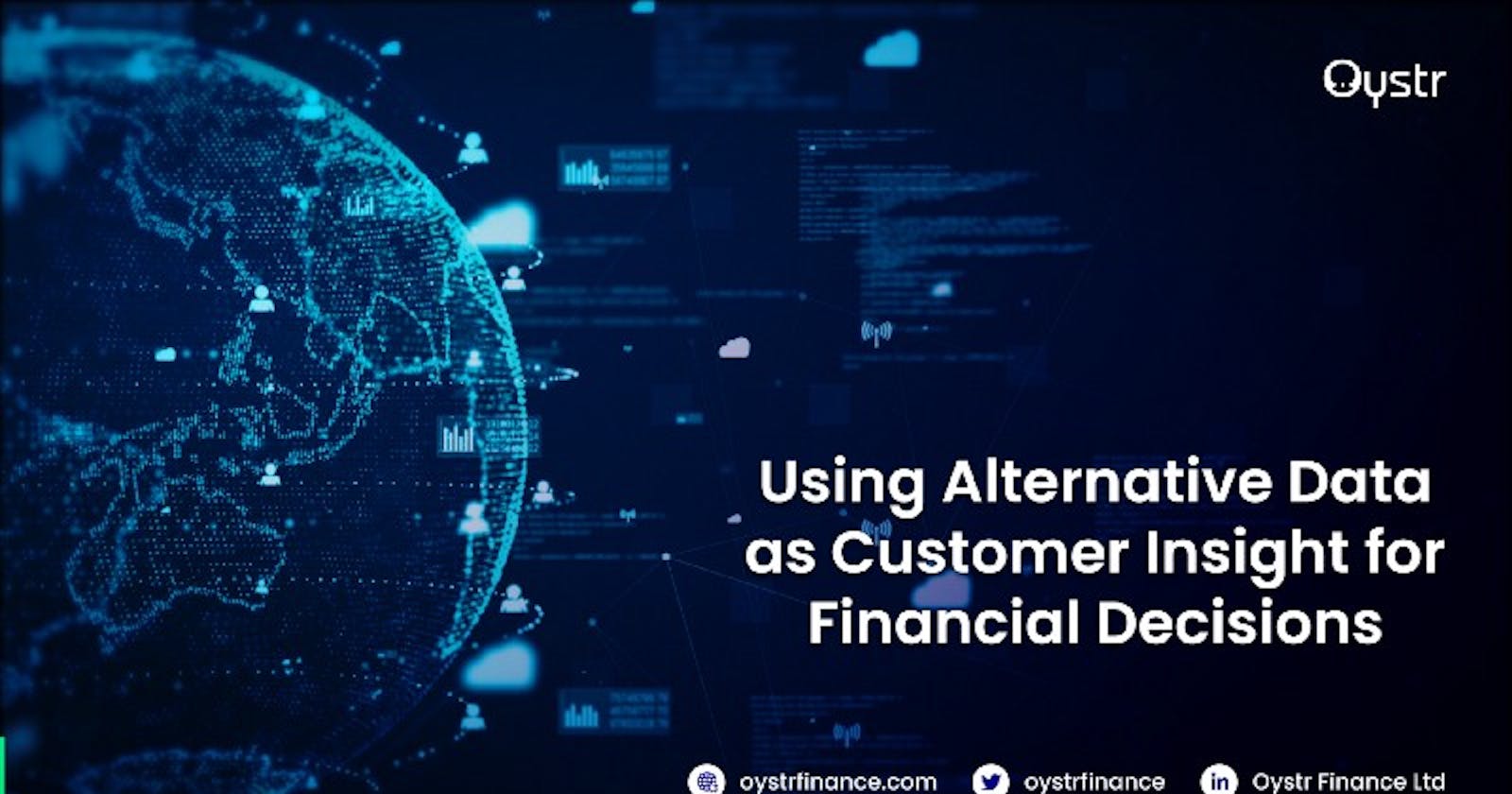Effective and strategic financial decisions require knowledgeable and up-to-date information in the constant transitions of a technologically advancing world. Alternative data stands at the core of the twenty-first century deliberate, tactical decision-making process in the finance world.
A Forrester research reveals that data-driven organizations grow averagely by over 30% annually. Data-backed decisions are strategic and often guarantee high operational efficiency, improved customer satisfaction, and remarkable ROI. The financial industry is undergoing a transformation as a result of big data, especially when consolidated with visualizations and machine learning algorithms.
Using Alternative Data as Customer Insight for Financial Decisions. (Oystr)
At the moment, technology is steadily improving humans’ ability to acquire, process, and analyze massive amounts of organized and unstructured data from unconventional sources. Analytics of these data reveal valuable insights into customer behavior. Customer insights (or consumer insights) are interpretations of quantitative and qualitative data gathered from trends in customer behavior, which are analyzed to inform financial decisions.
As a result, they increase the effectiveness and relevance of a product or service, marketing, sales, and service initiatives. As a result, various brands, industries, and others use consumer insights to assess their business ecosystem and make faster, fact-based decisions.
However, several organizations lack access to large amounts of customer feedback to make decisions; hence, they require data from alternative sources.
What Is Alternative Data?
The combination of big data technologies and customer analytics induced a quantum shift in modern-day finance. Abundant data is a treasure trove for organizations to extract insights for better-informed operational, risk, and management decision-making. Many organizations base their financial decisions on data obtained from traditional sources like stock offerings, financial records, and published reports.
However, the evolving industry trends show that quarterly earnings reports might be unreliable as the main data source for critical decision-making. Besides, some organizations generate low customer feedback and information. Hence, traditional sources are simply not sufficient. As a result, 95% of financial services organizations now establish their business decisions and success on external data.
The term alternative data describes financial data acquired from non-traditional sources, such that it cannot be generated from an organization’s own operations or obtained from official public sources. The financial services industry has long adopted it as an established niche practice. Still, a broader spectrum of B2C and B2B verticals are increasingly incorporating it into their data-driven strategies.

What Is Alternative Data?
Alternative Data as Customer Insight
Alternative data present larger, dynamic datasets capable of providing accurate and abundant customer insights– more insights mean better decisions and alpha. Integrating alternative data sets adds real-world context to internal financial decisions.
The datasets can be gathered from various sources and may be structured or unstructured. For example, alternative data could be user-generated (web traffic, app usage, social media), business-generated (banking records, credit card transaction records, supply chain data, government data), or sensor-generated (satellite imagery, weather predictions, geolocation), obtained through web-scraping, raw data acquisition or third party licensing.
Organizations gain more insights when applied to alternative data than traditional sources. This requires them to expand their data and develop analytical capabilities using machine learning and AI technology. Thus, essential information can be gathered from several different sources and integrated with a cohesive application.
The expansive information provided by alternative data sets reveals insights into consumer behavior, market trends, social sentiments, economic situations, consumer engagements, product popularity, sales volume, etc. These insights have multiple use cases across various decision-making processes and scenarios.
However, there are certain challenges in gaining insights from alternative data. These include a system’s ability to store and process the information, lack of understanding about analyzing big data, and the need for statistical analysis and backtesting to confirm its relevance. But, certain alternative data sources and marketplaces provide multiple datasets and how to analyze them.
Impact of Alternative Data on Financial Decisions
The ability of an institution to translate insights from advanced analytics or alternative data into action points positions it for success in any industry. Financial decisions cut across all spheres of influence– from individuals and businesses to industries and governments. They crucially determine the prospects of an organization. Alternative data has revamped financial decision-making from Brexit predictions and M&A deals to testing new ideas and opportunities. The impact of generating insights from alternative data in financial analysis for decision-making spreads across boards. Some include:

Impact of Alternative Data on Financial Decisions (Oystr)
Predictive Analytics
Alternative data allows analysts to examine historical and new data such as macroeconomic data, consumer information/feedback, industry trends, or petroleum prices. Such insights assess what’s relevant to a specific company and improve forecasting and decision-making.
Alternative data also helps draw correlations between events and performance to make predictions from public and company data. It enables financial deciders to factor in many different variables that could affect changes in the condition of a market or industry. These variables include the supply of goods/materials, consumer demand, and economic trends. For instance, alternative data can predict financial performance in a new market based on modeling done in a previous market.
[Understanding the Financially Underserved in Africa
In Africa, there are 600 million underserved people lacking financial inclusion. Access to alternative financial data…medium.com](https://medium.com/@Oystrfinance/understanding-the-financially-underserved-in-africa-9bfcab758870 "medium.com/@Oystrfinance/understanding-the-..")
Data Modeling
Clean, enriched alternative data strengthens regression and other analytics models. Different consequential patterns impact an organization. Identifying these patterns helps to create modeling of financial data from different sources. Alternative data introduces unique datasets into algorithms and analytics. These data uncover new consumer insights to build quant models and inform better financial decisions.
Competitive Edge
Alternative datasets such as social commentary, financial information, and personnel information of competitors give an organization a competitive advantage in a market. A better understanding of competitors in a market helps make financial decisions that place an organization on a pedestal in the market.
Alternative data also provides access to privileged information ahead of competitors. Official sources of information like financial reports typically provide accurate indicators of a business’s performance. However, they are only occasionally obtainable, as they are usually only released according to the company’s calendar or in response to a major event. Contrastly, companies tend to update their social media feeds more often to engage their customers.
These data give analysts a timely sense of an organization’s events and insights into customer interactions. As a result, they can help make informed decisions ahead of the competition.
Tracking of Market-Moving Events
Events such as pandemics, security attacks, natural disasters, and war influence markets and industries prominently. Alternative data empowers you with up-to-date information on macroeconomic events such as these. It subsequently influences prompt and proactive response and decision-making to prevent any serious financial consequence or crisis.
Financial decisions such as investments and currency trading, strongly affected by many market-moving events, use alternative data to track these events.
For instance, investment companies receive signals to provide predictive investment advice faster than some competitors.
Deal Sourcing
Research is critical for finding profitable deals that evade superfluous risks. Analysts from organizations such as hedge funds and private equity firms leverage alternative data in their research. Financial analysis enriched with customer insights from alternative data helps make better financial decisions and chase the right deals. Access to high-powered and quickly integrated alternative data insights also aids data investigation.
Risk Management
Alternative data gives access to data feeds that inform risk assessment in financial decision-making. Datasets related to adverse media, politically exposed person lists, sanctions, and company financial indicators, for instance, could be risk indicators. Analytics of such data aids measurement, management, and mitigation of risks in making financial decisions.
Sales/Demand Forecasting
Analysts employ alternative data to anticipate future increases or decreases in consumer demand for certain products or services. For instance, financial analysts can develop demand forecasting models by using alternative data like foot traffic or transaction data. These data can generate customer insight, such as how consumers interact with specific stores and brands. Financial decisions and forecasting models can be built from such analytics.
Customer Relationships
A critical aspect of a business is attracting, maintaining, and retaining customers. As a result, customer/user experience is a key part of every brand or industry. Brands strive to provide features or services that align with customer values to acquire customers and gain loyalty. Deriving insight from customer data insufficiently improves customer experience. However, more accurate and relevant customer insights are generated in combination with alternative data. It improves customer relationships with the brand and consequently boosts ROI.
The Internet contains a wealth of data translated into financial insights. Research, marketing, entertainment, and business transactions have been digitized. Alternative data such as web traffic and app usage provide insights into customers’ online activity, buying, bidding, and selling behaviors. Analysts use these customer insights to speculate how they might spend money in real life and inform financial decisions.
Conclusion
Many factors such as economic downturns and global pandemics influence the finance industry. Therefore, data-driven organizations leverage alternative datasets, machine learning algorithms, and artificial intelligence to make smart decisions backed by real data.
Alternative data is new, proliferating, and more interoperable and accessible despite its few challenges. However, these do not eliminate the need for traditional data. On the contrary, the combination of alternative data with traditional data and analytics harnesses its best value. Therefore, financial analysts and experts recommend alternative data strongly as customer insights for financial decisions.
With Oystr, financial institutions can access alternative or informal data in real-time and provide better services. Visit us to get started.

